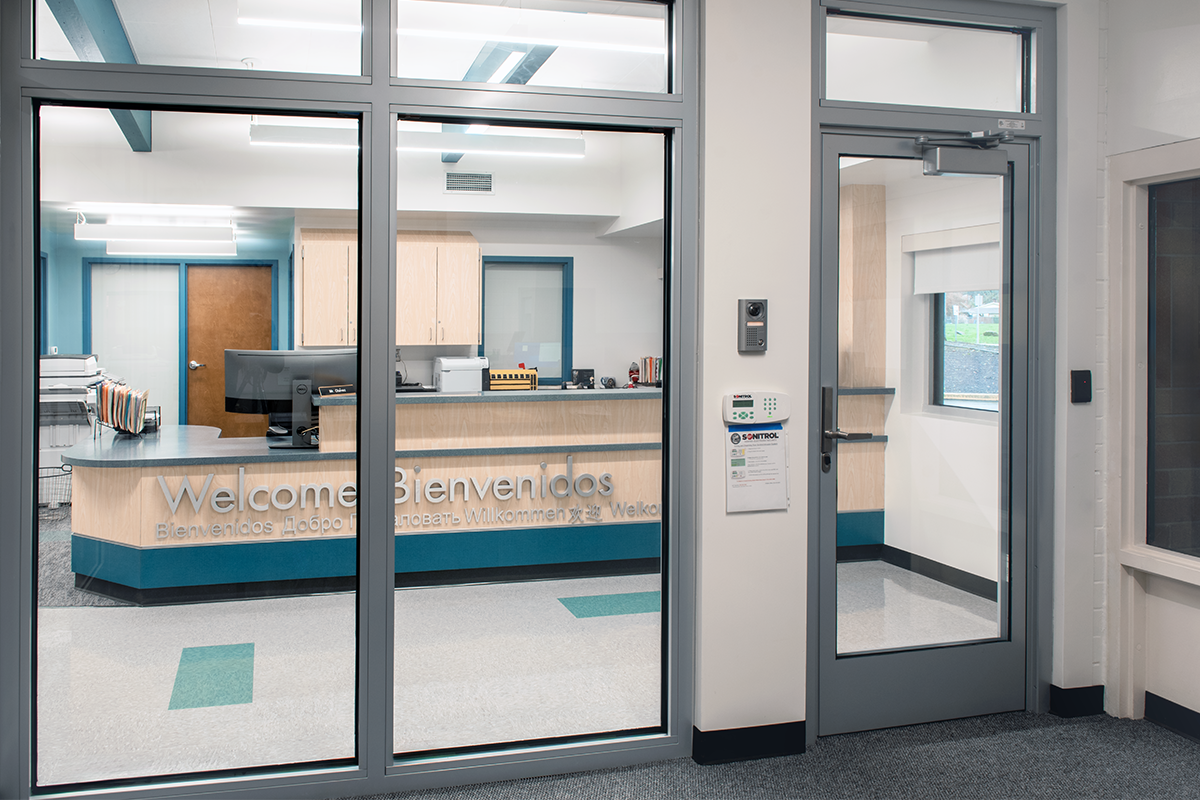Enhancing School Safety with Fire-Rated Glass Doors

Designing safe schools can have multiple meanings. For a security professional, it could mean understanding and applying the principles of Crime Prevention Through Environmental Design (CPTED). For a fire marshal, it could mean ensuring fire doors, including fire-rated glass doors, have ratings that meet local code requirements. For parents, teachers and students, it could mean floorplans that reduce places where students can be isolated and bullied.
Of course, all these approaches to safer school design overlap—because ultimately designing safe schools is about creating a space where occupants are equally protected from physical harm and supported mentally and emotionally.
Specialty glazing systems, like multifunctional, fire-rated glass, which combines fire and security ratings, can provide a solution to the challenge of designing for both. For example, unlike some other security systems, multifunctional, fire-rated glass doors can deter and delay violent intruders in an emergency while fading into the background during a routine day. This is partially due to their ability to offer a close visual match to non-rated glazing systems.
While states like Texas, Tennessee and Missouri have taken steps to codify enhanced security on schoolgrounds, there is currently a lack of national code-driven requirements that address school security. This can make navigating the design of safe schools less clear than it should be—especially when it comes to using specialty glazing to support code requirements and security goals simultaneously.
How do doors and windows fit with designing safe schools?
Openings within the built environment pose multiple challenges when designing safe schools. For instance, doors need to ensure occupants have a safe path of egress, but they also need to be able to delay intruders from gaining access to a school’s interior. Further to this point, non-security rated glazing in windows and doors can be seen as weak links along the building envelope.
While openings may need to meet several performance capabilities, doors and windows also offer an opportunity for project stakeholders. These systems, whether they are exterior windows or fire-rated glass doors, can be hardened to efficiently improve the level of safety and security a school building provides. That said, when designing to increase the security a school building can provide, project teams can incorporate best-practice guidelines from the Partner Alliance for Safer Schools (PASS) and other resources.
Forced-entry doors and windows contribute to safer school design
Code-compliant, security-rated glazing can support recognized best practices for designing safe schools. For example, forced-entry resistance-rated glass can be installed in windows and doors along the building envelope, including inside secure entry vestibules. Due to its ability to resist physical attack after being shot, this security-rated glass can delay violent threats from entering a school. Further, because it preserves sightlines into adjacent areas, it can help faculty more easily monitor incoming threats. This can buy schools time to contact first responders and decide their best course of action in response.
It is important to note that forced-entry rated glazing is not the only type of specialty glazing that can help architects design safe schools. Ballistic-rated glass can also be used to meet best-practice recommendations. When deciding which security-rated glass to use, specifiers are encouraged to consult with security professionals to determine which ratings will most closely meet their design goals.
How to support school safety with fire-rated glass
Because the National Fire Protection Association (NFPA) estimates that there are over 7,000 fires on schoolgrounds annually, it is crucial for those designing safe schools to consider fire and life safety. These considerations often mean defending paths of egress from fire, smoke and radiant heat, but they can also include strategies for compartmentalizing large, open areas within the built environment. To that end, fire-rated glazing, including fire-rated glass door systems, can support code-compliant designs without compromising visual connection and access to daylight.
For openings, fire-rated glass doors, wall panels and windows can help specifiers meet code requirements without having to sacrifice visual connection between spaces. When specifying these systems, it is important that building professionals understand the rating requirements for a given application.
Fire-rated glass can be fire-protective or fire-resistive—and which rating type is permissible in an opening is determined by local code requirements. For fire-rated glass doors, the differences in weight and thickness in these types of fire-rated glass may require different performance capabilities for the framing systems and hardware used. Specifiers can work with manufacturers like Technical Glass Products to determine which systems best meet their needs for code-compliant school designs.
What to do when security goals and code requirements overlap
As safer school design becomes more prominent, school project teams may identify areas that could benefit from security-rated products and must meet code requirements for fire and life safety. In these instances, meeting both security goals and code requirements is more difficult than combining a security-rated product with a fire-rated one.
This is partially due to testing protocols. Security-rated products are often only tested to the standards that govern their use and not others. Similarly, fire-rated products are only required to pass their specific industry tests, including the fire and hose stream tests. Because knowledge of how these components react in different emergency situations is limited, combining them into a multifunctional, fire-rated system may lead to unintended consequences that compromise the performance of one or both parts to the system. For example, because security-rated components can burn quickly and intensely, they can surpass fire test protocols. This can reduce or negate the level of protection these systems may provide.
When a multifunctional, fire-rated glass door system uses components that are known to be compatible or is tested as a complete system, it can help ensure one form of protection is not sacrificed for another. This can help project stakeholders more effectively design safe schools that are also code compliant.
Fire-rated glass doors can meet code requirements and more
Just as there are many considerations for safer school design, there are many avenues to designing safe schools. Often to ensure a school achieves its security goals and meets building code requirements, it is encouraged for project teams to take a collaborative approach to design. This can range from meeting with security professionals to discussing system specifications with manufacturers. Doing so helps improve a school design from a safety and security perspective as well as one that supports occupant experience.
While there are many strategies to achieve these goals, security-, fire- and multifunctional, fire-rated glass door and window systems can be essential in turning safer school designs into real life buildings.


 Devin Bowman is General Manager of Technical Glass Products (TGP) and AD Systems. With nearly 20 years of industry experience, Bowman is actively involved in advancing fire- and life-safety codes and sits on the Glazing Industry Code Committee (GICC).
Devin Bowman is General Manager of Technical Glass Products (TGP) and AD Systems. With nearly 20 years of industry experience, Bowman is actively involved in advancing fire- and life-safety codes and sits on the Glazing Industry Code Committee (GICC).